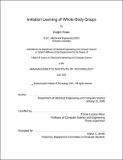| dc.contributor.advisor | Tomász Lozano-Pérez. | en_US |
| dc.contributor.author | Hsiao, Kaijen | en_US |
| dc.contributor.other | Massachusetts Institute of Technology. Dept. of Electrical Engineering and Computer Science. | en_US |
| dc.date.accessioned | 2006-07-31T18:19:33Z | |
| dc.date.available | 2006-07-31T18:19:33Z | |
| dc.date.copyright | 2005 | en_US |
| dc.date.issued | 2005 | en_US |
| dc.identifier.uri | http://hdl.handle.net/1721.1/33761 | |
| dc.description | Thesis (S.M.)--Massachusetts Institute of Technology, Dept. of Electrical Engineering and Computer Science, 2005. | en_US |
| dc.description | This electronic version was submitted by the student author. The certified thesis is available in the Institute Archives and Special Collections. | en_US |
| dc.description | Includes bibliographical references (p. 152-154). | en_US |
| dc.description.abstract | Humans often learn to manipulate objects by observing other people. In much the same way, robots can use imitation learning to pick up useful skills. A system is demonstrated here for using imitation learning to teach a robot to grasp objects using both hand and whole-body grasps, which use the arms and torso as well as hands. Demonstration grasp trajectories are created by teleoperating a simulated robot to pick up simulated objects, and stored as sequences of keyframes in which contacts with the object are gained or lost. When presented with a new object, the system compares it against the objects in a stored database to pick a demonstrated grasp used on a similar object. Both objects are modeled as a combination of primitives-boxes, cylinders, and spheres-and the primitives for each object are grouped into 'functional groups' that geometrically match parts of the new object with similar parts of the demonstration object. These functional groups are then used to map contact points from the demonstration object to the new object, and the resulting adapted keyframes are adjusted and checked for feasibility. Finally, a trajectory is found that moves among the keyframes in the adapted grasp sequence, and the full trajectory is tested for feasibility by executing it in the simulation. The system successfully uses this method to pick up 92 out of 100 randomly generated test objects in simulation. | en_US |
| dc.description.statementofresponsibility | by Kaijen Hsiao. | en_US |
| dc.format.extent | 154 p. | en_US |
| dc.format.extent | 6506574 bytes | |
| dc.format.extent | 6537019 bytes | |
| dc.format.mimetype | application/pdf | |
| dc.format.mimetype | application/pdf | |
| dc.language.iso | eng | en_US |
| dc.publisher | Massachusetts Institute of Technology | en_US |
| dc.rights | M.I.T. theses are protected by copyright. They may be viewed from this source for any purpose, but reproduction or distribution in any format is prohibited without written permission. See provided URL for inquiries about permission. | en_US |
| dc.rights.uri | http://dspace.mit.edu/handle/1721.1/7582 | |
| dc.subject | Electrical Engineering and Computer Science. | en_US |
| dc.title | Imitation learning of whole-body grasps | en_US |
| dc.type | Thesis | en_US |
| dc.description.degree | S.M. | en_US |
| dc.contributor.department | Massachusetts Institute of Technology. Department of Electrical Engineering and Computer Science | |
| dc.identifier.oclc | 67616801 | en_US |
